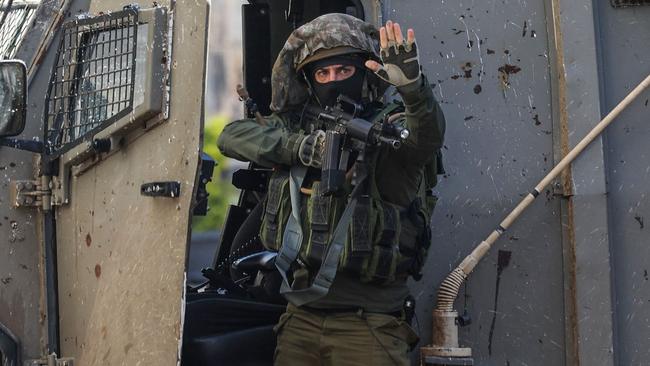Israel-Hamas war enters deadlier phase with more close combat
The Israeli military and Palestinian officials are reporting heavy losses in intense fighting in the Gaza Strip.

The Israeli military and Palestinian officials are reporting heavy losses in intense fighting in the Gaza Strip, as Israel faces pressure to quickly achieve its goal of eliminating Hamas.
Describing one of the deadliest days for Israeli forces in Gaza since the war began two months ago, Israel said that 10 soldiers were killed on Wednesday in the northern part of the enclave in a battle featuring face-to-face urban combat with Hamas fighters.
Since the start of the war, 115 Israeli soldiers have died and around 600 have been injured in Gaza, according to the Israeli military. That is a greater number of casualties than Israel’s military experienced in previous Gaza ground offensives. At least 20 of the Israeli military fatalities were accidents, mostly the result of friendly fire.
“I’m worried we will declare victory before winning the war,” said Danny Danon, an Israeli MP in Prime Minister Benjamin Netanyahu’s Likud party. “We need to clarify what exactly are the goals of the war, what it really means to win and eradicate Hamas.”
An average of 280 Palestinians are dying in Gaza daily, according to Palestinian authorities. More than 18,600 people in Gaza have been killed in the war, most of them women and children, according to authorities there. The numbers don’t distinguish between civilians and combatants. The Israeli military estimates several thousand Hamas militants have died in the war.
Israel faces growing direct pressure from the US to wind up active combat operations in Gaza. Israeli Defence Minister Yoav Gallant, when asked if Israel was adapting its war tactics to conform with American requests to minimise civilian casualties, said that “no one decides for us how to act”.
“I think we’ll find the way to help the Americans help us. They want us to succeed,” he added.
White House national security adviser Jake Sullivan is due to arrive in Israel on Friday, and said he would speak with Mr Netanyahu about timetables for ending major combat.
Mr Sullivan said this doesn’t mean Israel must stop going after Hamas, which the US considers to be a terrorist group. “It just means that you move to a different phase from the kind of high-intensity operations that we see today,” he said during an appearance at a forum hosted by The Wall Street Journal.
Joe Biden and Mr Netanyahu sparred on Tuesday over who should govern the Gaza Strip after the war. Mr Biden said his administration would like the Palestinian Authority, which rules parts of the West Bank, to take control over Gaza. Mr Netanyahu forcefully rejected the US proposal. He previously said the Israeli military was planning to maintain indefinite control of the strip.
Despite the high death tolls in Gaza, neither Israel nor Hamas appears willing to back down from fighting soon, and each is pressing the other to surrender.
Hamas has cast the recent Israeli fatalities as a propaganda victory. “Your failed leadership has no regard for the lives of your soldiers,” the group said. “You have no choice but to withdraw from Gaza. The longer you stay there, the greater the bill of your deaths and losses will be.” The higher Israeli casualties reflect a shift in the military’s war tactics, with a greater focus on urban, ground combat and more targeted operations. In the earlier weeks of the war, Israel relied almost exclusively on air bombardments.
“The more widely we operate as we do in the strip, the more encounters we have [with militants] and unfortunately the more wounded,” said Israeli military spokesman Daniel Hagari. He said the fighting also leads to many militants being killed or surrendering.
Conducting warfare house to house and “checking things from up close instead of destroying them from far away” is part of Israel’s strategy to reduce civilian casualties, said Shalom Ben Hanan, a former senior Israeli intelligence official. But that is coming at a price for Israeli troops, and in military and security circles some are beginning to question the strategy, he said.
“I’m already hearing criticism that it’s not OK, and we have to fight differently, that we have to fight in a way that is safer for IDF soldiers,” said Mr Ben Hanan, who is in touch with his former colleagues. They are asking “if it is essential to battle this way, versus with tanks and planes”. Some military analysts say Israel would need at least two more months to effectively root out Hamas.
“If we have until the end of January, we will most likely achieve the strategic aim of dismantling the bulk of Hamas’s military capabilities,” said Miri Eisin, a retired colonel in Israel’s military intelligence.
Israel’s second war goal – recovering 135 hostages its military said are still held by Hamas – will likely require negotiations, which Israel may press through more military action, she added.
One of Israel’s biggest outstanding challenges is to dismantle Hamas’s roughly 500km-long tunnel network, critical for the group to move fighters and supplies, she said. On Tuesday, Israel began flooding it with seawater.
With intense air bombardments and ground combat taking place in northern and southern Gaza – and the healthcare system disintegrating – the war is entering a deadly new phase.
The Wall Street Journal



To join the conversation, please log in. Don't have an account? Register
Join the conversation, you are commenting as Logout